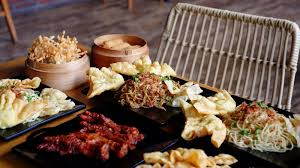Spin the Slot: How MiegaCoanMenu’s Daily Specials Keep Dining Exciting
On a Monday night, someone drops by after work, tired and hungry, not in the mood to study a long menu. The chalkboard near the bar does the heavy lifting. “Grilled leeks with anchovy vinaigrette, lemon, and breadcrumbs.” They take a chance. What arrives is simple, smoky, and bright. The first bite feels sharper than expected, and by the end of the plate, they’ve found a new vegetable to love.
Thursday brings another guest, one who usually orders steak. They glance at the specials and pause. “Smoked mackerel with citrus farro and fennel.” Not their usual order, but curiosity wins. It’s lighter than they thought, the smoked fish playing against the crunch of grain and the hit of lemon. They finish the plate smiling, already thinking of who they’ll tell about it tomorrow.
By Sunday, a third diner slips in for a quiet meal. The special reads: “Braised lamb neck with cumin yogurt and blistered tomatoes.” The server mentions it’s running low, maybe ten plates left. Suddenly it feels like catching the last act of a show. They order without hesitation, and when the dish lands—deep, rich, and comforting—they know they made the right move.
Three diners, three nights, three dishes. The common thread isn’t just good food. It’s the sense of timing, of being in the right place at the right moment. At MiegaCoanMenu, the specials board is more than a side attraction. It’s the part of the restaurant that keeps the energy alive, where routine turns into surprise. Specials here spin like a wheel: every day brings a new combination, and the anticipation is part of the fun—just like the slots.
The Mechanic of Surprise
Why do daily specials work so well? Because people love a reveal. A rotating board keeps guests leaning forward. It triggers questions that feel small but matter: What’s tonight’s dish? What did I miss yesterday? What might show up next week?
Surprise sticks when it has structure. Too much chaos makes a menu confusing. Too much repetition makes it dull. MiegaCoanMenu strikes a balance by keeping a rhythm. There’s usually one strong centerpiece dish—a roast, a braise, a grill. There’s often a lighter wildcard—something bright, quick, or unusual. Anchors hold the week together: a soup, a salad, or a side that ties back to the house style. That rhythm lets diners feel grounded while still chasing novelty.
The payoff is emotional as much as it is culinary. Guests start to anticipate not only tonight’s plate but also the story behind it. A diner who missed last night’s tomato-and-burrata special feels a small tug of regret, which only makes them more likely to return tomorrow. Another who caught the smoked fish feels part of an inside moment. The specials board builds not just meals but little arcs of loyalty.
Scarcity sharpens the thrill. When a dish runs out after twenty servings, it feels like proof of authenticity rather than a marketing ploy. Guests begin to time their visits around the board, the way people line up for the first batch of croissants at a bakery. The board creates habits, but in a way that feels playful instead of pressured.
Even the language matters. A short, clear board works better than one crammed with adjectives. Guests want to know the dish, the star ingredient, and maybe one or two details about texture or flavor. “Braised lamb neck with cumin yogurt and blistered tomatoes” is enough. It leaves room for curiosity.
In short, surprise works best when it’s framed, not random. The mechanics—headliners, wildcards, anchors, scatters—give chefs a toolkit and diners a reason to look up from their phones and read the board.
Kitchen as Game Designer
Behind the scenes, daily specials don’t happen by accident. They rely on choreography, much like a stage show that changes acts each night but keeps the set steady. The backbone of prep—stocks, sauces, dressings, and base roasts—stays constant. From that scaffold, the team spins variations.
Cross-use of ingredients makes this possible. A batch of roasted squash purée might become a soup starter on Monday, a spread under grilled mushrooms midweek, and the base for a risotto on Friday. Citrus zest flavors both a marinade and a dessert sugar. Fish bones from one delivery build a broth that seasons another dish. Each ingredient gets multiple lives, and each life feels fresh because of context.
Suppliers play a big role. A farmer calls with too many eggplants? They’ll appear charred under yogurt on Wednesday and diced into a relish on Saturday. A fisherman offers sardines? They’ll headline the grill night instead of tuna. These pipelines let the restaurant pivot while keeping waste low.
Risk stays contained through prototypes. A dish might run for one night as a wildcard. If it sells, if the kitchen handles it smoothly, and if the feedback is good, it might return. If it stumbles, it gets reworked into something else. This low-stakes testing keeps creativity alive without betting the whole week on an unproven plate.
Feedback is constant. The team tracks what sells quickly, what lingers, and what returns half-eaten. Servers report common questions or hesitations. Notes are logged and referenced when the same ingredients come back around. Over time, the specials board becomes a diary of what the neighborhood responds to and what needs adjusting.
To the diner, it looks effortless. To the kitchen, it’s a careful balance of structure and play. Mise en place is tight. Garnishes are ready. Swap options are clear. The board spins smoothly because the backstage work is disciplined.
Players at the Table
Specials don’t just change food—they change the room. Regulars and explorers both find reasons to come. Regulars see the specials as a continuation of the kitchen’s voice, variations on themes they’ve come to trust. Explorers see each dish as a one-night-only performance, a reason to drop in now rather than later.
Scarcity creates honest urgency. When a server says, “We’ve got about fifteen plates left,” guests know it’s real. Sold-out dishes rotate—sometimes the roast, sometimes the seafood—so no one feels manipulated. Instead, they feel tuned in to the rhythm of the kitchen.
Word of mouth builds naturally. Someone posts a photo of last night’s lamb, and suddenly others feel they missed out. Another guest shares a story about a dish that surprised them, and friends make plans to visit together. The specials board becomes its own kind of advertising, powered by diners rather than marketing.
Servers play a crucial role. A good description—short, specific, and sensory—makes all the difference. “Tonight’s special is braised pork shoulder with apple glaze and spiced cabbage. It’s rich, a little sweet, and pairs well with the house lager.” That kind of language paints the picture without overselling. Guests feel informed rather than pitched to.
Patterns emerge. Some guests learn that Thursday is the night for smoke and char. Others show up Sundays for long braises. Small communities form around these rhythms, and the dining room gains a club-like energy without exclusivity. People swap notes across tables about what they had last week or what they hope shows up again.
Occasional events keep things lively. A “greatest hits” week brings back the most-requested dishes. A harvest dinner highlights produce from a single farm. A component-swap night lets diners assemble variations from shared elements. Each keeps the specials board from becoming predictable, while still speaking the same language.
The Math Behind the Magic
Creativity is only half the story. Numbers keep the wheel turning. Specials have to work within clear margins, or the board stops making sense.
Every dish gets costed: ingredients, prep time, predicted sales, and waste risk. Specials can carry slightly lower margins if they raise the check average in other ways—maybe a lighter dish encourages guests to order dessert, or a braise pairs naturally with a higher-margin wine.
Waste shapes choices too. A glut of tomatoes can become sauce for one dish and garnish for another. Herb stems flavor oils while leaves top salads. Scraps become stocks. Specials absorb surplus without ever looking like “use-up” plates. Diners see thoughtful cooking, not thrift.
Pricing flexes with demand. On a slow Tuesday, a special might come in at a friendlier price with a bundled side. On a packed Saturday, the same dish might be plated with richer accompaniments and priced accordingly. The key is transparency: the description always matches the plate. Guests never feel tricked.
The kitchen hedges with versatile staples—grains, legumes, aromatics, eggs—so last-minute changes don’t derail service. If tuna doesn’t arrive, sardines step in. If mushrooms look poor, brassicas take their place. This flexibility keeps the board alive without panic.
Simple tools support the math. A one-page template covers plate cost, contribution margin, and two substitution options. A swap matrix pairs proteins, vegetables, starches, and sauces so pivots happen in seconds. Suppliers learn the rhythms too, offering seasonal surprises that often become wildcards. Over time, relationships deepen, and the specials board becomes part of a wider ecosystem of trust.
Culture, Community, and Return Trips
Daily specials create rituals. A “Smoked Thursday” becomes something locals look forward to all week. A “Coastal Sunday” brings quieter plates that still feel special. These names become part of the neighborhood vocabulary. Guests return not only for the food but also for the rhythm itself.
Collaboration adds texture. A nearby baker contributes bread for a limited run. A rooftop farmer provides herbs that star in a garnish. A cooking school sends students to prep for one night, and the restaurant shares the results openly. Specials become a canvas for community stories.
Memory hooks keep guests coming back. A simple stamp card for “five reels completed” rewards diners with a chef’s-choice tasting or a behind-the-scenes tour. It’s not about points—it’s about being part of an ongoing conversation.
Small stories carry more weight than slogans. The guest who always orders the spiciest plate becomes known by staff. The line cook’s chili oil gets requested by name. A server’s notes on guest preferences turn into a pattern of small surprises. These details build loyalty one person at a time.
The team itself learns through repetition. Pre-shift meetings cover the day’s board, a quick taste, and one key note from yesterday. Post-shift notes track what ran out, what slowed the pass, and what guests asked about. The loop builds steady improvement without fanfare.
Even online presence reflects this honesty. A weekly photo of the board, a quick story about a farmer or a prep task, and genuine replies to comments keep guests engaged. The posts don’t chase virality; they extend the same conversation already happening at the tables.
How to Keep the Wheel Spinning
The specials board works because it balances two opposites: structure and play. Structure holds the core menu steady and sets the rhythm. Play lives in the daily dish, the wildcard, the scatter of herbs or sauces that shift week by week. Together, they keep the room alive.
For the kitchen, it means calm prep and tight organization. For the servers, it means clear, honest narration. For suppliers, it means steady demand with room for surprises. For diners, it means anticipation every time they walk in.
Each special builds on the last. A hit dish comes back refined. A miss teaches a lesson. A pattern forms, then shifts. Over time, the specials board becomes a story of growth, of seasons, of the neighborhood’s tastes.
The real currency isn’t coins or margins—it’s attention, care, and timing. Guests return not because they expect perfection, but because they know tomorrow will hold something they haven’t seen yet. The board spins again, the plates land, and the dining room hums. Tomorrow’s special hasn’t been written, and that’s exactly why people keep showing up.







